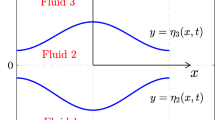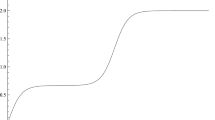Abstract
Rayleigh–Taylor instabilities occur when a light fluid lies beneath a heavier one, with an interface separating them. Under the influence of gravity, the two fluid layers attempt to exchange positions, and as a result, the interface between them is unstable, forming fingers and plumes. Here, an analogous problem is considered, but in cylindrical geometry. Two line sources are present within an inner region of lighter fluid, and each of them has an inwardly directed gravity field. The surrounding fluid is heavier and is pushed outward by the light inner fluid ejected from the two sources. Nonlinear inviscid solutions are calculated and compared with the results of a linearized inviscid theory. In addition, the problem is formulated as a weakly compressible viscous outflow and modeled with Boussinesq theory. It is found that vorticity is generated in the viscous interfacial zone but that overturning plumes do not develop. However, the solution growth is highly sensitive to initial conditions.














Similar content being viewed by others
References
Rayleigh Lord (1883) Investigation of the character of the equilibrium of an incompressible heavy fluid of variable density. Proc Lond Math Soc 14:170–177
Sir Taylor GI (1950) The instability of liquid surfaces when accelerated in a direction perpendicular to their planes. I. Proc R Soc Lond Ser A 201:192–196
Sharp DH (1984) An overview of Rayleigh–Taylor instability. Phys D 12:3–18
Moore DW (1979) The spontaneous appearance of a singularity in the shape of an evolving vortex sheet. Proc R Soc Lond Ser A 365:105–119
Cowley SJ, Baker GR, Tanveer S (1999) On the formation of Moore curvature singularities in vortex sheets. J Fluid Mech 378:233–267
Baker G, Caflisch RE, Siegel M (1993) Singularity formation during Rayleigh–Taylor instability. J Fluid Mech 252:51–78
Krasny R (1986) Desingularization of periodic vortex sheet roll-up. J Comput Phys 65:292–313
Baker GR, Pham LD (2006) A comparison of blob-methods for vortex sheet roll-up. J Fluid Mech 547:297–316
Forbes LK (2009) The Rayleigh–Taylor instability for inviscid and viscous fluids. J Eng Math 65:273–290
Kelley MC, Dao E, Kuranz C, Stenbaek-Nielsen H (2011) Similarity of Rayleigh–Taylor Instability development on scales from 1 mm to one light year. Int J Astron Astrophys 1:173–176
Kull HJ (1991) Theory of the Rayleigh–Taylor instability. Phys Lett 206:197–325
Inogamov NA (1999) The role of Rayleigh–Taylor and Richtmyer–Meshkov instabilities in astrophysics: an introduction. Astrophys Space Phys 10:1–335
Waddell JT, Niederhaus CE, Jacobs JW (2001) Experimental study of Rayleigh–Taylor instability: low Atwood number liquid systems with single-mode initial perturbations. Phys Fluids 13:1263–1273
McClure-Griffiths NM, Dickey JM, Gaensler BM, Green AJ (2003) Loops, drips, and walls in the galactic chimney GSH \(277+00+36\). Astrophys J 594:833–843
Low M-MM, McCray R (1988) Superbubbles in disk galaxies. Astrophys J 324:776–785
Epstein R (2004) On the Bell–Plesset effects: the effects of uniform compression and geometrical convergence on the classical Rayleigh–Taylor instability. Phys Plasmas 11:5114–5124
Mikaelian KO (2005) Rayleigh–Taylor and Richtmyer–Meshkov instabilities and mixing in stratified cylindrical shells. Phys Fluids 17:094105
Yu H, Livescu D (2008) Rayleigh–Taylor instability in cylindrical geometry with compressible fluids. Phys Fluids 20:104103
Forbes LK (2011) A cylindrical Rayleigh–Taylor instability: radial outflow from pipes or stars. J Eng Math 70:205–224
Matsuoka C, Nishihara K (2006) Analytical and numerical study on a vortex sheet in incompressible Richtmyer–Meshkov instability in cylindrical geometry. Phys Rev E 74:066303
Forbes LK (2011) Rayleigh–Taylor instabilities in axi-symmetric outflow from a point source. ANZIAM J 53:87–121
Forbes LK (2014) How strain and spin may make a star bi-polar. J Fluid Mech 746:332–367
Gómez L, Rodríguez LF, Loinard L (2013) A one-sided knot ejection at the core of the HH 111 outflow. Rev Mex Astron Astrofis 49:79–85
Stahler SW, Palla F (2004) The formation of stars. Wiley-VCH, Berlin
Forbes LK (2001) The design of a full-scale industrial mineral leaching process. Appl Math Model 25:233–256
Ulvestad JS, Wrobel JM, Carilli CL (1999) Radio continuum evidence for outflow and absorption in the Seyfert 1 galaxy Markarian 231. Astrophys J 516:127–140
Morris M, Sahai R, Matthews K, Cheng J, Lu J, Claussen M, Sánchez-Contreras C (2006) A binary-induced pinwheel outflow from the extreme carbon star, AFGL 3068. Planetary nebulae in our galaxy and beyond. In: Barlow MJ, Méndez RH (eds) Proceedings IAU symposium no. 234, pp 469–470. doi:10.1017/S1743921306003784
Forbes LK, Chen MJ, Trenham CE (2007) Computing unstable periodic waves at the interface of two inviscid fluids in uniform vertical flow. J Comput Phys 221:269–287
Farrow DE, Hocking GC (2006) A numerical model for withdrawal from a two-layer fluid. J Fluid Mech 549:141–157
Batchelor GK (1967) An introduction to fluid dynamics. Cambridge University Press, Cambridge
Hamming RW (1973) Numerical methods for scientists and engineers. McGraw-Hill Inc., New York
von Winckel G (2004) lgwt.m, at: MATLAB file exchange website, written. http://www.mathworks.com/matlabcentral/fileexchange/loadFile.do?objectId=4540&objectType=file. Accessed 11 Dec 2007
Atkinson KE (1978) An introduction to numerical analysis. Wiley, New York
Kreyszig E (2011) Advanced engineering mathematics, 10th edn. Wiley, New York
Anton H (1980) Calculus with analytic geometry. Wiley, New York
Lee HG, Kim J (2012) A comparison study of the Boussinesq and the variable density models on buoyancy-driven flows. J Eng Math 75:15–27
Saff EB, Snider AD (1976) Fundamentals of complex analysis for mathematics, science and engineering. Prentice-Hall, Englewood Cliffs
Acknowledgments
This work was carried out in association with Australian Research Council Grant DP140100094. Comments from three anonymous referees are gratefully acknowledged.
Author information
Authors and Affiliations
Corresponding author
Appendix
Appendix
In this Appendix, the integrals defining the constants \({\mathcal {C}}_n (\beta )\) and \({\mathcal {S}}_n (\beta )\) in Eq. (28) are calculated in closed form, using the calculus of residues. For convenience, attention is focussed purely on the two integrals in these definitions, which are written here as
These are converted into contour integrals in a complex \(z\)-plane, in the standard manner (see Saff and Snider [37, Sect. 6.2]). The integrals can be regarded as describing a single revolution on the unit circle \(|z| = 1\), parametrized as \(z = \exp (\mathrm{i}\theta )\). The two trigonometric functions are eliminated according to the formulae
and the terms in Eq. (60) are expressed as
In this expression, the four terms
have been defined for convenience. Each of them is a contour integral about the unit circle traversed once in the positive direction, as illustrated in Fig. 15.
The contour used in the complex plane, along which the integrals in Eq. (62) are evaluated. The (red) stars denote the possible locations of pole singularities. (Color figure online)
The two terms \(J_1\) and \(J_3\) appearing in Eq. (62) are straightforward to evaluate, since they each only contain a simple pole at the single point \(z = \mathrm{i}\beta \) within the unit circle (since \(\beta < 1\)). The residue at this point is easily obtained, and it follows that
The integrand of the term \(J_2\) in Eq. (62) has both a simple pole at \(z = \mathrm{i}\beta \) as well as a pole of order \(n-1\) at the origin \(z = 0\). The residue of the simple pole is easy to calculate, but that of the high-order pole at the origin is more difficult. It is appropriate to use partial fractions to re-write this expression as
In this form, the residue of the pole of order \(n-1\) at the origin may now be obtained by differentiation, and a little algebra gives the simple final form
A similar use of partial fractions is applied to the expression for \(J_4\) in (62), since it too involves a simple pole at the point \(z = \mathrm{{i}}\beta \) and a pole of order \(n+1\) at the origin \(z=0\). This quantity can therefore be calculated to be
These four expressions in Eqs. (63), (64), (65) are now substituted into the expressions (61) for \(K_n\) and \(L_n\), and yield the results
These formulae now give the final forms (29) in the text.
Rights and permissions
About this article
Cite this article
Forbes, L.K. Planar Rayleigh–Taylor instabilities: outflows from a binary line-source system. J Eng Math 89, 73–99 (2014). https://doi.org/10.1007/s10665-014-9710-9
Received:
Accepted:
Published:
Issue Date:
DOI: https://doi.org/10.1007/s10665-014-9710-9





